Into the Stormtroopers. Part Two
Today’s post has nothing to do with wine. This is part two of a true story about a presidential assassination attempt, the American Nazi Party and the de-evolution of truth. SPOILER ALERT; please read part one HERE first. All photographs ©1981 Donald Carter.
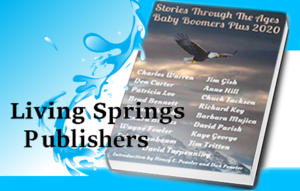
NOTE: “Into the Stormtroopers Part One and Part Two” was published in Living Springs Publishers anthology, Stories Through The Ages Baby Boomers Plus 2020.
“This is a must-read story about the tumultuous events that abruptly thrust Don Carter into the international spotlight and an adventure of a lifetime … Don’t miss this gripping, page-turning mystery about events that every baby-boomer will remember. Don won second prize with his story.”
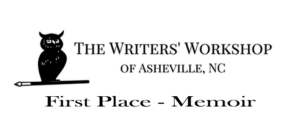
NOTE: “Into the Stormtroopers Part One and Part Two” is the First Prize winner in the 2017 Writer’s Workshop of Asheville “Memoir” competition.
“… writing style is impressive, and the descriptions were vivid. The content is gripping, unusual and page-turning!” The Writer’s Workshop of Asheville.
 NOTE: The literary journal New Millennium Writings awarded this article Honorable Mention.
NOTE: The literary journal New Millennium Writings awarded this article Honorable Mention.
The De-Evolution of Truth
“It was a bright cold day in April, and the clocks were striking thirteen.”
― George Orwell, 1984
May 1981
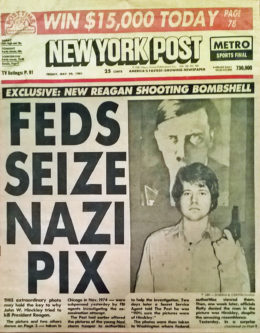
The phone rang at dawn and as I pulled the receiver close a metallic shout from the caller jolted me upright and awake.
“FEDS SEIZE NAZI PIX!”
“Wha …?”
“The New York Post. Front page. FEDS … SEIZE … NAZI … PIX!”
Five minutes later I stood sockless at the corner newsstand, scrutinizing the front page of the New York Post. Two familiar Nazis stared back. Adolf Hitler’s portrait hung in the background, his stare intense and chilling. A young neo-Nazi with a raised pistol in hand stood in the foreground, his expression unreadable and lifeless – but no less chilling. My eyes went to the photo credit beneath the picture where I found my name.
I was no journalist. When I took the picture six years earlier I’d been a teenage art student shooting an exposé of Nazi activity for a college photography assignment. If I’d been a journalist I would have written down the names of my subjects. Instead I’d spent the past two months struggling to learn the true identity of the man now staring back at me from the newsstand.
I secured the resources of the New York Post to help uncover the truth but when the District Attorney in Washington D.C. got wind of my “bombshell” photo-documentary the truth proved irrelevant. No longer interested in the young Nazi’s true identity, The Post ran the story on page one because, “Yesterday, in a surprise move, two [FBI] agents quietly returned to the Manhattan office of photographer Don Carter with a subpoena for the negatives.”¹
Today the word truth is conveniently presented between a pair of bobbing fingers. Tabloid television, fake news, and alternative facts contribute to a systemic American malady symptomized by “quotation truth”. Much like “Newspeak”, the language George Orwell created in his novel 1984, the corrosive de-evolution of truth radiating from Washington and perpetuated by mercenary media outlets is designed to create an alternate reality – a reality that rewrites history and contradicts all that we know to be true. Orwell forewarned, “The very concept of objective truth is fading out of the world. Lies will pass into history.”
Do we give up all hope of objective truth the moment we let others manipulate our perception of reality? Once we take that leap of faith – whether with a parent, teacher, political party or the press – do we become nothing more than the manipulated sycophants of a thousand well-orchestrated lies?
In 1981 it hadn’t occurred to me that truth could be subjective, opinion, or mutable and my single-minded mission had been to discover the truth (sans-quotation marks) about the pictures that would soon make their way into magazines around the world. The September 1981 issue of American Photographer magazine reported,
While agencies like Sygma and Gamma/Liaison were turning over their files for pictures of young blond Nazis, Carter was painstakingly trying to identify the young man who had posed for him before a picture of Adolf Hitler. Eager to obtain a positive i.d., Carter, now a videotape editor in New York City, called the Post and offered exclusive first rights if the paper would do the legwork.²
At a midnight meeting in lower Manhattan with New York Post columnist Steve Dunleavy (the tabloid TV reporter better known for his work on A Current Affair) the newspaper agreed to turn the images over to their contacts at the Secret Service. The subsequent newspaper article revealed that, “Two days later a Secret Service Agent told The Post he was “90% sure” of the man’s identity.”
After two months of fruitless research, the FBI subpoena had come as a welcome development, a signal that perhaps the truth would finally be revealed. Could the young neo-Nazi be, as the Justice Department suspected, the same man who had recently attempted to assassinate President Ronald Reagan? Was it possible I’d spent an afternoon discussing hollow-tipped bullets with the insane gunman John Hinckley Jr.?
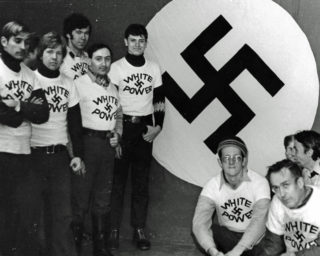 When I slipped into the Chicago headquarters of the National Socialist Party of America I had focused on Frank Collin, leader of the NSPA and a brazen white supremacist who was running for a seat on the Chicago city council. Soon afterwards Collin garnered national media attention when he attempted to lead his troops through the streets of Skokie, Illinois.
When I slipped into the Chicago headquarters of the National Socialist Party of America I had focused on Frank Collin, leader of the NSPA and a brazen white supremacist who was running for a seat on the Chicago city council. Soon afterwards Collin garnered national media attention when he attempted to lead his troops through the streets of Skokie, Illinois.
The monochromatic Collin proved to be a disappointing photography subject and my attention shifted to a younger Nazi sporting a .357 Magnum on his hip. After securing his trust, the young man posed for the portraits that were now in the possession of the U.S. Assistant District Attorney in Washington D.C.
*****
Two Months Earlier
It was a bright cold day in April when I heard the news that Hinckley had gunned down President Reagan, Secret Service agent Tim McCarthy, police officer Thomas Delahanty and White House Press Secretary James Brady, who succumbed to his wounds decades later. In the days following the shooting, sketchy details of Hinckley’s involvement in the American Nazi Party surfaced. Like a ghost rattling its chains outside memory’s doorway, something in these reports was haunting me. For days I consciously ignored what my subconscious would not, and when the weekend arrived I succumbed to an irrepressible urge to catch up on events with the Sunday New York Times.
25-year-old John Hinckley is charged with attempting to assassinate President Reagan, and his apparent fascination with the National Socialist Party and his brief reported association with the neo-Nazi group remain an important focus of the Federal Government’s investigation.³
In the years between shooting my photo documentary and the shooting of the president, Frank Collin had lost control of the National Socialist Party of America and a new generation of leaders had emerged. The Times article went on to report,
Two successive leaders of the American Nazi group, Mr. Allen and Harold Covington, have said that Mr. Hinckley was a member … Mr. Allen, the party leader, said that ”character assessment” reports from Mr. Breda to Mr. Collin, the party leader at the time of the Skokie march, suggested that ”basically, he was uncontrollable” and openly preached violence.³
The National Socialist Party? Mr. Collin? The Skokie march? It took about a thousand gigawatts of clues but the cerebral light bulb finally switched on and for the first time since the shooting I took a good look at the images of John Hinckley Jr. in the newspaper and thought, “We’ve met before.”
I bolted the attic steps two at a time and located the box where the residue of my college years had settled in sedimentary layers. Like an archeologist on a bone I located the photographs and spread them across the floor.
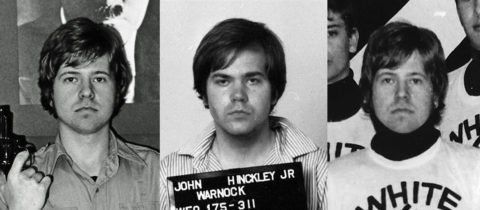
The similarities were unmistakable despite a six-year lapse between photographs. The downturned corners of his mouth, the cupid’s bow of his upper lip, the narrow bridge, ball and nostril flare of his nose, the bend of his eyebrows, the curl of his sideburns around the base of his ears, even the blemishes on his neck and cheeks, all mirrored the images of Hinckley assembled by The Times. When combined with the article linking Hinckley to Frank Collin and the Chicago NSPA, I was convinced I had hit the photojournalism jackpot.
I glanced up to find my fiancé Caroline looking over my shoulder and realized that in the countless hours we’d spent getting to know each other I had neglected to mention my infiltration of the American Nazi Party. The iconic Nazi imagery spread across the attic floor combined with the New York Times headlines about the Reagan shooting had her wondering who the hell she was about to marry. Clearly Caroline did not share my enthusiastic response to learning I was somehow connected to the attempted assassination of the President of the United States.
Hours after my epiphany in the attic I met with editors at the New York Daily 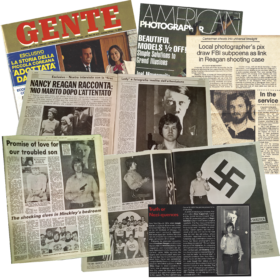 News, United Press, and TIME Magazine, before eventually striking the midnight deal with the New York Post. I later signed with Outline, a photo agency anxious to represent my images in Europe and negotiations in Paris, Munich, Milan, London and half a dozen other European markets followed.
News, United Press, and TIME Magazine, before eventually striking the midnight deal with the New York Post. I later signed with Outline, a photo agency anxious to represent my images in Europe and negotiations in Paris, Munich, Milan, London and half a dozen other European markets followed.
The struggle to uncover the truth became paramount after false Hinckley images surfaced, making media outlets reluctant to publish unsubstantiated photographs. American Photographer magazine wrote,
Following the attempted assassination of President Reagan, and the ensuing scramble for Hinckley photos, many magazines and newspapers ran pictures that turned out to be frauds.
Outline, the photo agency representing Carter … made “an unusual deal” in selling the photos to Time, Paris Match, Bunte, Gente, and the London Daily Mirror, even though their editors are not able to publish them unless it is proven that their subject is truly Hinckley.²
Over the next two months I engaged in a series of exchanges with the FBI and the prosecuting District Attorney. More than once I felt the tap of paranoia on my shoulder. After all, I was raised on a steady diet of conspiracy theories surrounding the assassination of John F. Kennedy. Government lies and CIA manipulation of the press had been well documented through disclosures about the Pentagon Papers and Operation Mockingbird. As I looked into the faces of the Nazis inhabiting my photo essay I couldn’t help but wonder if there might be a real-life Manchurian Candidate staring back.
Ronald Reagan recovered from the assassination attempt and went on to complete two full terms as President. James Brady struggled with his injury for the remainder of his life and died in 2014. His death was ruled a homicide as a result of the wounds he sustained during the assassination attempt but prosecutors elected not to press murder charges against Hinckley. In 1982 John W. Hinckley Jr. was found innocent by reason of insanity and spent 35 years in a psychiatric hospital.
I still don’t know if the man I met in the Chicago Nazi Party headquarters was the man responsible for the murder of James Brady and the attempted assassination of President Reagan, but a document I recently obtained through the Freedom of Information Act has confirmed that in April 1981 the Director of the FBI received a request to “perform a full photographic comparison of these photos with photos of subject John Warnock Hinckley, Jr.”. To this day the agency has remained silent on the results of their investigation and the man’s true identity remains publicly unknown.
*****
Today
The recent rise of the “alt-right” movement and the violence that erupted in Charlottesville, Virginia has rekindled interest in my decades-old encounter with the American Nazi Party and the fruitless search for truth that followed.
What is more dangerous, the racial contempt displayed by a small group of white supremacists in Chicago or Charlottesville, or the implicit encouragement of an administration that emboldens people of hate to act against people of color? I have stood toe to toe with the pistol-toting, swastika-wearing variety of racism and from my perspective the inflammatory rhetoric of those in power, cloaked in Orwellian doublespeak and designed to fuel the cultural resentments buried in our national psyche, is far more dangerous. Racism, which was once secretly concealed beneath America’s thin white skin, is now blatantly displayed on our inflamed red necks.
When “alt-right” ideology becomes mainstream and “alternative truth” competes with “objective truth” for the attention of our nation, it’s time to look back and examine the road that got us here, a road that passed through Selma in the sixties, Chicago in the seventies, and now passes through Washington D.C. When America comes to the next fork in that road the direction we choose depends on the strength of our people to see through the artifice, obfuscation and misdirection of those trying to alter what is real.
Pulitzer Prize winning author Thomas E. Ricks wrote, “The struggle to see things as they are is perhaps the fundamental driver of Western civilization … It is the agreement that objective reality exists, that people of goodwill can perceive it, and that other people will change their views when presented with the facts of the matter.”4
Meanwhile, Big Brother is watching.
¹ FEDS SEIZE NAZI PIX (May 29, 1981) New York Post, 1
² IN CAMERA (Sept. 1981) American Photographer, 10
³ King, W. (April 13, 1981) Hinckley Inquiry Studies Alleged Nazi ‘Flirtation’, The New York Times, 20
4 Ricks, T. E. (2017) Churchill & Orwell The Fight For Freedom, 270




















